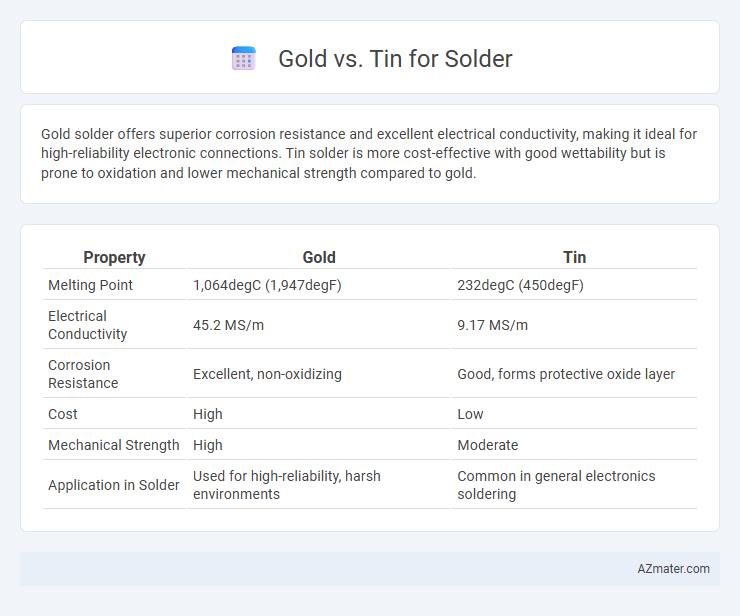Gold solder offers superior corrosion resistance and excellent electrical conductivity, making it ideal for high-reliability electronic connections. Tin solder is more cost-effective with good wettability but is prone to oxidation and lower mechanical strength compared to gold.
Table of Comparison
| Property | Gold | Tin |
|---|---|---|
| Melting Point | 1,064degC (1,947degF) | 232degC (450degF) |
| Electrical Conductivity | 45.2 MS/m | 9.17 MS/m |
| Corrosion Resistance | Excellent, non-oxidizing | Good, forms protective oxide layer |
| Cost | High | Low |
| Mechanical Strength | High | Moderate |
| Application in Solder | Used for high-reliability, harsh environments | Common in general electronics soldering |
Introduction to Gold vs Tin Solder
Gold solder offers superior corrosion resistance and excellent electrical conductivity, making it ideal for high-reliability electronic connections. Tin solder is more cost-effective and widely used in standard electronics due to its good wettability and ease of melting. Choosing between gold and tin solder depends on factors such as application requirements, environmental conditions, and budget constraints.
Chemical Properties: Gold vs Tin
Gold boasts excellent resistance to oxidation and excellent corrosion resistance due to its inert chemical nature, making it an ideal material for reliable solder joints. Tin, a more reactive metal, readily forms tin oxide layers that can affect solderability but enhances wetting properties in solder alloys. The difference in chemical stability between gold and tin directly influences their performance in electronics, where gold offers superior longevity and tin provides cost-effective, efficient bonding.
Electrical Conductivity Comparison
Gold offers superior electrical conductivity compared to tin, with a conductivity of approximately 45.2 MS/m, while tin measures around 9.17 MS/m, making gold significantly more efficient for electrical signal transmission. This high conductivity in gold reduces energy loss and enhances performance in sensitive electronic connections. Tin's lower cost and adequate conductivity make it popular for general soldering, but gold's excellent conductivity is preferred in high-reliability, high-frequency, and precision electronics applications.
Melting Points and Workability
Gold solder melts at approximately 1064degC, significantly higher than tin solder, which melts around 232degC, making tin more suitable for delicate electronic components requiring low-temperature processing. Tin solder exhibits superior workability due to its lower melting point and excellent wetting properties, allowing for easier application and stronger joint formation. Gold solder, while offering enhanced corrosion resistance and conductivity, demands higher temperatures that can increase thermal stress on components and reduce ease of use.
Corrosion Resistance and Durability
Gold offers superior corrosion resistance compared to tin, preventing oxidation and preserving solder joint integrity over time. Tin, while more economical, is prone to oxidation and can degrade under harsh environmental conditions, reducing long-term durability. The enhanced longevity and reliability of gold solder make it ideal for high-performance electronics and critical applications requiring stable, corrosion-resistant connections.
Cost and Availability Factors
Gold solder is significantly more expensive than tin solder due to the high cost of gold material, making it less feasible for large-scale or budget-sensitive projects. Tin solder, widely available and affordable, remains the standard choice for most electronics manufacturing because it offers a balanced combination of cost-effectiveness and reliable performance. The abundant supply and lower market price of tin ensure consistent availability, while gold's scarcity and premium price limit its practical use mainly to specialized applications requiring superior corrosion resistance and electrical conductivity.
Applications in Electronics
Gold offers excellent conductivity and corrosion resistance, making it ideal for high-reliability electronic applications such as connectors and circuit boards. Tin solder, commonly used due to its cost-effectiveness and good wetting properties, is prevalent in general electronics assembly, especially in surface-mount and through-hole soldering. In advanced electronics, gold plating enhances signal integrity and longevity, while tin-based solders provide versatility and ease of use in mass production.
Reliability and Joint Strength
Gold solder provides superior reliability and joint strength due to its excellent resistance to oxidation and corrosion, ensuring long-lasting electrical connections in harsh environments. Tin solder offers good joint strength with lower cost but is more susceptible to tin whiskers and thermal fatigue, which can compromise long-term reliability. For critical applications, gold-based solder alloys enhance durability and maintain stable mechanical and electrical properties over time.
Environmental and Safety Considerations
Gold solder offers excellent corrosion resistance and is non-toxic, making it environmentally safer compared to tin-based solder, which can release harmful fumes such as tin oxide or lead contaminants during heating. Tin solder, especially lead-free variants, has improved safety profiles but may still produce volatile organic compounds (VOCs) and particulate matter that pose respiratory hazards. Proper ventilation and protective equipment are crucial when working with any solder to minimize exposure to toxic substances and reduce environmental impact.
Choosing the Right Solder for Your Project
Gold solder offers superior conductivity and corrosion resistance, making it ideal for high-reliability electronic projects, while tin solder is more affordable and easy to use for general-purpose applications. Choosing the right solder depends on factors such as the operating environment, mechanical stress, and electrical requirements of your project. Prioritize gold solder in aerospace, medical devices, or high-frequency circuits where performance and longevity are critical, and opt for tin-based solder in consumer electronics and prototyping for cost-effective joins.

Infographic: Gold vs Tin for Solder
 azmater.com
azmater.com